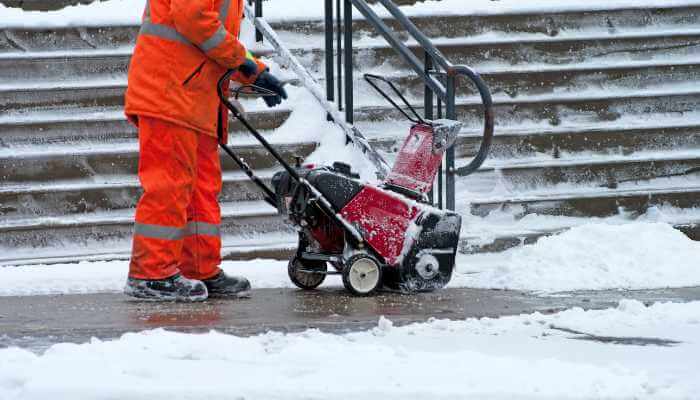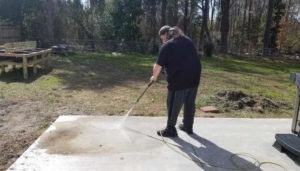
Ice does not often happen in North Carolina. So, when a freeze is forecasted in my area, I like to ensure my home will be accessible for my family and me. The last thing I want is for someone to slip on the ice outside my house.
The easiest way to prevent slips and falls in winter is to clear the snow and ice from your walkway.
There are many ways to do this. Some are better than others. Here, this non-expert will go into just a few tips. The following tips can help clear your walkway of ice, but not all are right or safe for all surfaces.
1. Shovel It
Some people get fancy and use a hand-pushed snowblower to remove ice from their walkways. This is definitely doable, especially with those powerful augers. I’ve never used a snowblower, but I’ve researched it and seen it done. Most dealers and homeowners will tell you that you may need to work this in layers. Also, some snowblowers come with bladed extensions to help with ice. Those can be useful. Most importantly, clear the snow and ice slowly. Otherwise, you could end up burning up the motor and getting the equipment repaired.
A good choice for a cordless snow shovel would be the Snow Joe Cordless Snow Shovel from Amazon.
An ice scraper is a handheld tool with a metal blade on one end, which is used to scrape ice off windows and windshields. It’s just like the scraper you use on your car, but smaller and made for the sidewalk. You can buy one at any hardware store or online. I have used one of these only once, and it worked well. Just be careful not to damage your walkway. I wound up leaving it with our last house…oops.
The one we purchased that worked so well for us was the Snow Joe 7-inch Steel Ice Chopper from Amazon.
A shovel is probably the most common method of clearing ice from your walkway. The best thing about using a shovel is that you don’t have to bend over as much as other tools like scrapers. Also, you usually have a shovel on-hand for the duty if you have yard tools around. Again, be careful to avoid scoring your walkway, especially if the shovel is worn. You may want to use a push-broom first, then go over it with a shovel.
Our recommendation would be the True Temper Aluminum Scoop Shovel.

Boost’s Tips
If you have the time to wait, don’t shovel the walkway until the ice has thawed with heat from the sun.
Shoveling is a long, tedious process that can take hours. You have to stand on a slippery surface while using a cumbersome tool, which makes it especially dangerous. Shoveling doesn’t always work. Sometimes the ice is too thick, or you don’t have the strength to break it apart. Don’t forget– you can use sand or kitty litter as traction aids when shoveling snow and icy slush away from driveways and sidewalks.
2. Spread Salt or Sand
My grandmother used ice cream or rock salt mixed with sand on her stoop when it iced over. Some people use a salt and vinegar solution. The salt melts the ice through chemical reactions with liquid water on the sidewalk’s surface, allowing you to easily brush away what remains.
However, some people prefer to stay away from salt. Using salt can harm plants growing near your sidewalk due to its high concentration of sodium chloride (NaCl). You may also damage concrete or asphalt surfaces if you don’t use an anti-icing agent before the salt. Salt works well on ice when it’s still new and fresh, but once the ice has been around for a while and started melting, it stops being effective.
A shovelful of sand or a few cups of kitty litter can also do wonders. Kitty litter is made of clay and has a melting point that’s high enough to melt ice. Kitty litter creates a lot of heat when it comes into contact with water. Just pour some kitty litter into a bucket or container and fill it halfway with hot water. Then pour it onto the icy spot on your walkway and let it sit there for a few minutes before rinsing off.
3. Use Melt-Down Products
De-icer sprays and granules can help melt ice fast. Still, they can also damage concrete and walkways if they’re not used correctly or when they aren’t necessary. The best way to use these products is as directed on the package label. Make sure you follow all instructions carefully!
Use calcium chloride, magnesium chloride, or potassium chloride for more stubborn patches of ice. Just an FYI – Potassium chloride performs slower than calcium chloride, rock salt, and magnesium chloride. There are scientific reasons for this, but I wanted to stay on the subject here.
If you have a small patch of ice or snow and the temperatures have not gotten below 20°F, sprinkle baking soda over the snow or ice and watch it disappear. Baking soda is acceptable in a pinch, in the situations I mentioned above, but it is limited to this. Typically it’s not used because it will take a long time for the chemical reaction to occur.
Another option is to use a simple vinegar spray. Using alcohol is another option for deicing, and it works exceptionally well in those temperatures just around the freezing point.
Snow makes it harder for heat to reach through and melt the ice underneath it. So you’ll want to clear away snow before trying any of these previous methods. I’ve always used a push broom for this since we don’t often get snow and ice.
4. Heat It Up
Use heated mats for zones in which ice is especially tough to clear. People in snow-prone areas use long melting mats for stairs and even on their roofs to help remove ice dams. These are electric and usually corrosion-resistant.
Some friends of ours said the RHS Snow Melting System worked for their roof.
There are other kinds of mats that I’ve found that fold de-icing agents into a fabric casing. This is the first time I’ve seen one of these before. According to the brand Saltnets, these mats are eco-friendly and pet safe, which are essential features for many of us.
Another way to melt snow and ice from your walkway is by using boiling hot water. This method is simple and inexpensive — all you need is a pot and some boiling water! The downside is that it takes longer than using sand or other household items, and the boiling water, at the correct temperatures, can either refreeze or become gas.
In Conclusion
If you’re anything like me, you hate dealing with the ice that accumulates on your sidewalk. I have found and shared some helpful tips that make it easier to handle. Some of these I’ve tried myself. What’s your preferred way to deal with this pesky problem?














